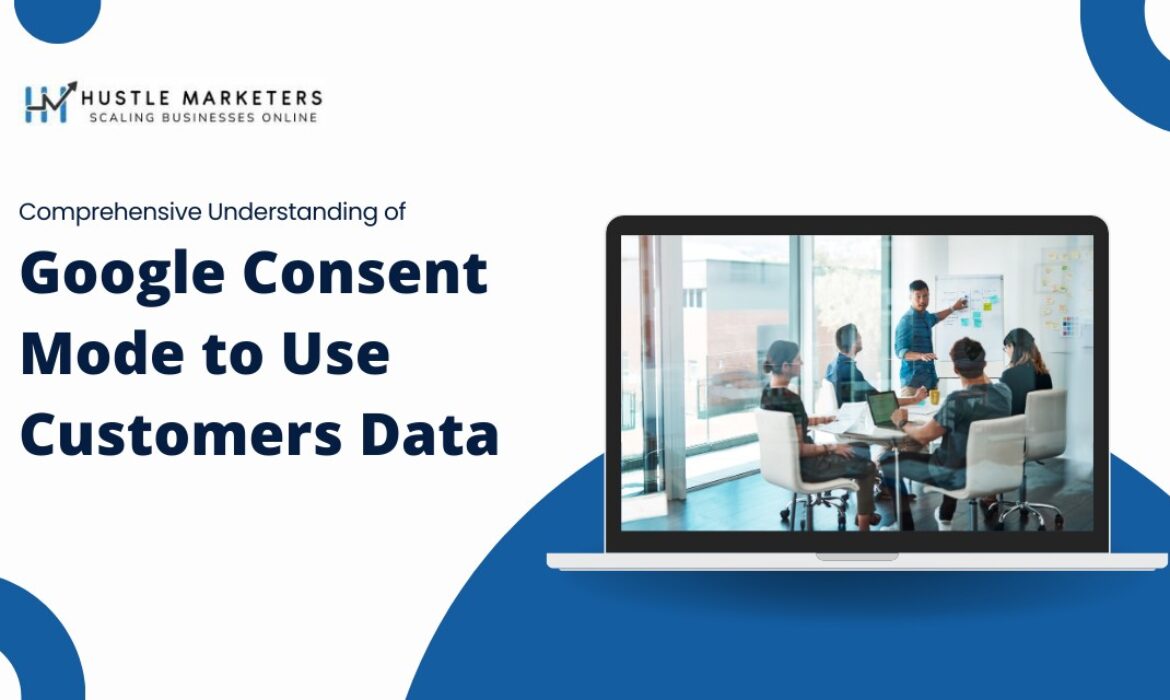Google Consent Mode: How It Works & Implement for User Data
Indeed, sheer efforts in the digital marketing service spectrum have grown to an exponential extent. Started off with SEO marketing, social media, PPC, and email, to now data-driven marketing provides substantial results to digital brands. Data is an integral aspect of all such marketing efforts to ensure desired results. Obviously, marketers rely on consented user’s data to analyze their behavior and target accordingly. This is where the role of Google Consent Mode comes into play.
The rising importance of maintaining digital privacy has led online marketers to use customers’ data in compliance with the General Data Protection Regulation (GDPR). At the time of saving cookies and allowing users permission to utilize and analyze their data, helps marketers offer personalized marketing offers.
Therefore to fully protect the user’s data, it is of vital importance to follow the Google Consent Mode.
And, here in this blog, we will be discussing important details related to Google Consent Mode, a privacy solution to enable result-driven digital marketing efforts.
Table of Content
What is Google Consent Mode?
How Does Google Consent Mode Work?
Why Use Google Consent Mode?
Benefits of Implementing Google Consent Mode?
How to Implement Google Consent Mode in GTM?
Let’s get started on the same.
What is Google Consent Mode?
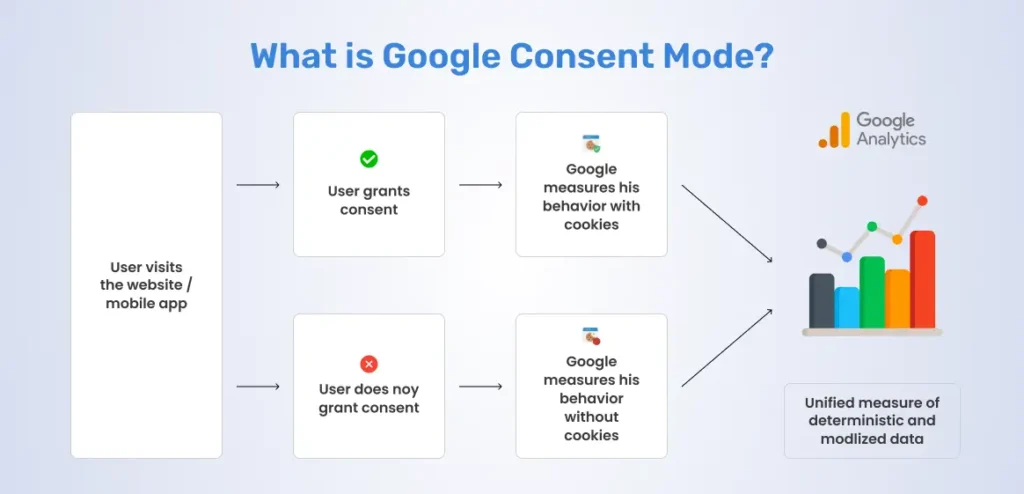
Google Consent Mode is a smart application programming interface (API). It empowers the digital marketing company’s experts that hire to monitor users’ activity after their consent. Thus, this API further allows the marketers to analyze user’s data for marketing purposes and that too in compliance with GDPR.
Definitely, for a better understanding, let me define Google Content Mode in the following way.
- You see this kind of Privacy pop up on your website and across various websites.
As per this pop, you ask the visitor to accept the cookies that save the user’s website accessibility information for further analytics. Unquestionably, when you hire a digital marketing company in India, their experts analyze the user’s preferences via an analytics platform and plan marketing efforts accordingly.
- In case, users click on the deny option, then you treat such people as normal users.
To be precise, by enabling Google Consent Mode, you take the user’s permission or consent to utilize their browsing patterns and website usage experience for further marketing efforts. And, then get insights by using additional tools like Google Analytics, Google Tag Manager, and Google Ads.
To create a trusted digital world, it is important on your part to leverage the virtues of Google Consent Mode API and take the necessary steps toward user privacy. By showcasing such a consent pop, you can gain the trust of the target audience and allow them to access your services or products.
Just remember the fact that for enabling consent mode, it is of integral importance to implement code in the head section before implementing Google Tag Manager (GTM).
How Does Google Consent Mode Work?
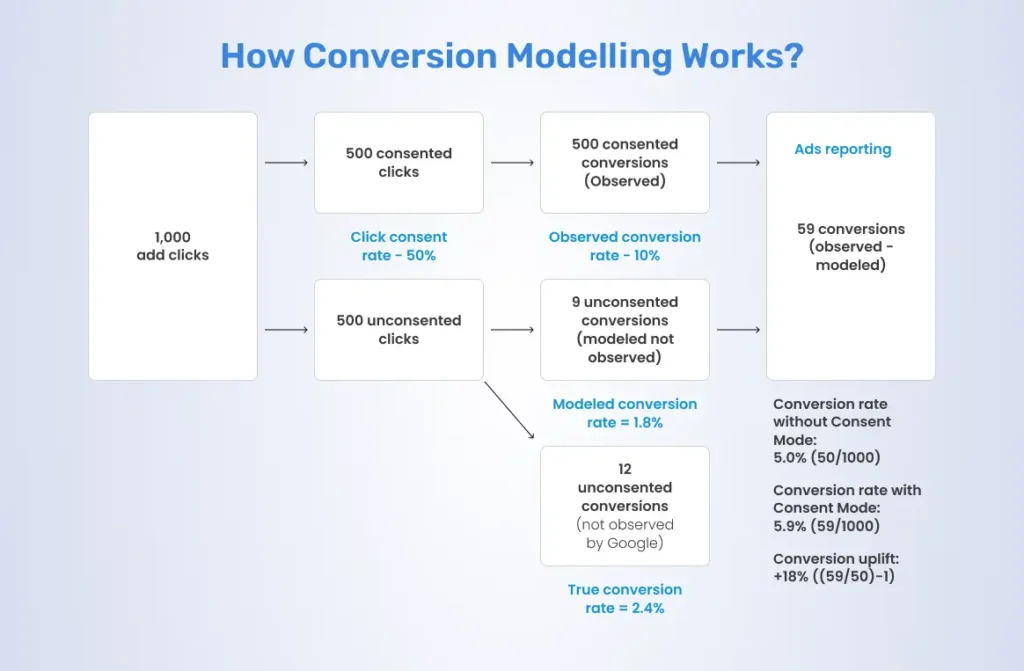
Consent Mode is more like a permission-driven API that helps gather user’s information after the consent. It informs Google about user’s choices related to website cookies or app permissions. This, in turn, influences the Google Tags to behave according to the user’s persona.
- When users enable the consent mode and interact with cookies, it helps adjust Google Analytics, ads, and several other tags.
- When a user clicks on the ad, followed by an action, then Google receives such information, without storing the user’s personal details.
- Google will collect data when more users click on the consent mode. Its further driven to analytics. And, later utilized for customized marketing efforts.
The two-step process of letting Google Consent Mode work for you
Generally, Google Consent Mode users two tags based on the following set of processes.
Tag 1: Ad Storage Tag
With an ad-storage tag, Google Consent Mode (GCM) controls your website’s marketing cookies and enables the following:
- It assures your business website notes and measures the campaign’s conversions.
- Allow your marketing insights in compliance with GDPR.
- Alter the Google Tags to analyze user’s behavior.
- Allow the Google Tags to change behavior.
Tag 2: Analytics_Storage
As the name itself implies, the analytics_storage tag of Google Consent Mode controls the statistical cookies of your website.
- Measure the user’s agent.
- Measure ad click information.
- Measure timestamps.
- Measure a Random number per page load.
Here’s the list of different types of Google Consent Mode
Different types of consent taken from users before storing their information.
- Personalization_storage: Take personalized consent from users to create customized recommendations.
- Funtionality_storage: Informationg gets stored to enable specific functionality of a website.
- Security_storage: User authentication-related information is stored.
- Analytics_storage: This consent is required to store information for data purposes like knowing the user visits to measure the sessions.
- Ad_storage: Consent taken for advertising purposes and enable customized marketing tactics.
Why Use Google Consent Mode?
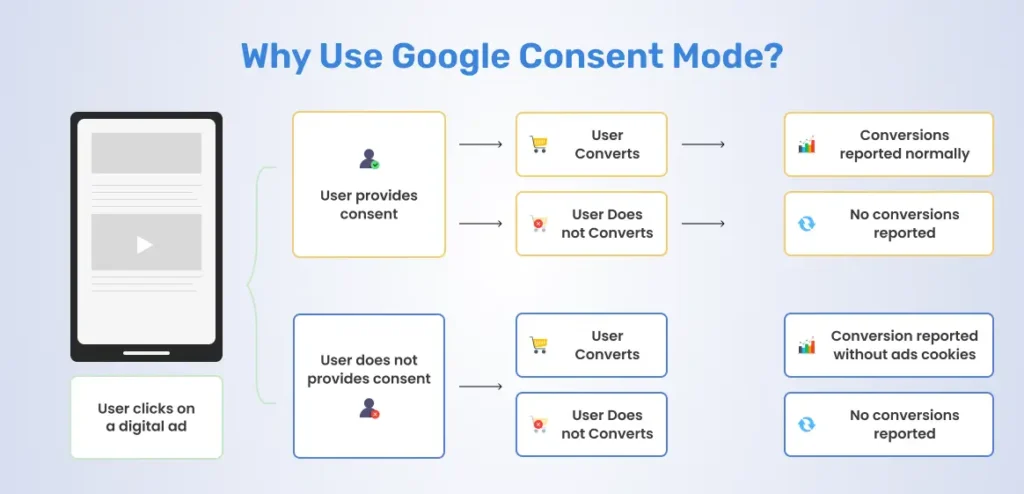
Here are some reasons Google Consent Mode is important for you
- Know the rate of lost conversions that did not happen due to not getting the user’s consent.
- Enable this mode to easily comply with regulatory requirements and protect the personal information of users.
- Prepare Google Analytics to gather more data and analyze the same.
- It’s a futuristic privacy feature for Google to measure user behavior for a long-lasting time.
Here, we have the list of entities who can make the most out of Google Consent Mode.
- Those who rely on Google advertising for tracking conversions.
- Integrate with Google Analytics to best track user behavior and conversion factors.
- Future proof of the measurement of users and their behavior with Google Consent Mode.
Benefits of Implementing Google Consent Mode?

Undoubtedly, this specific API brings manifold benefits for your digital business to become more data-driven.
- This feature allows the websites to comply in a data-driven way, after consent or not getting consent from users. No matter what, companies can get insightful information about users to take specific action ahead.
- Google Consent Mode offers transparency to users, whether or not share their personal information. This enables lasting trust built for your brand and helps nurture customers for a long-lasting time.
- Different levels of consent allow your business to drive personalized marketing campaigns with the objective of increasing customer base, conversion, & generating leads.
- Another significant benefit of leveraging Google Consent Mode is reducing the number of privacy and cookies pop-ups on the website screen. Doing this will not annoy users to click on accepting or rejecting cookies again and again.
- Lastly, this API helps enhance your online business is speeding up the loading time. This in turn allows users to quickly see the content.
How to Implement Google Consent Mode in GTM?
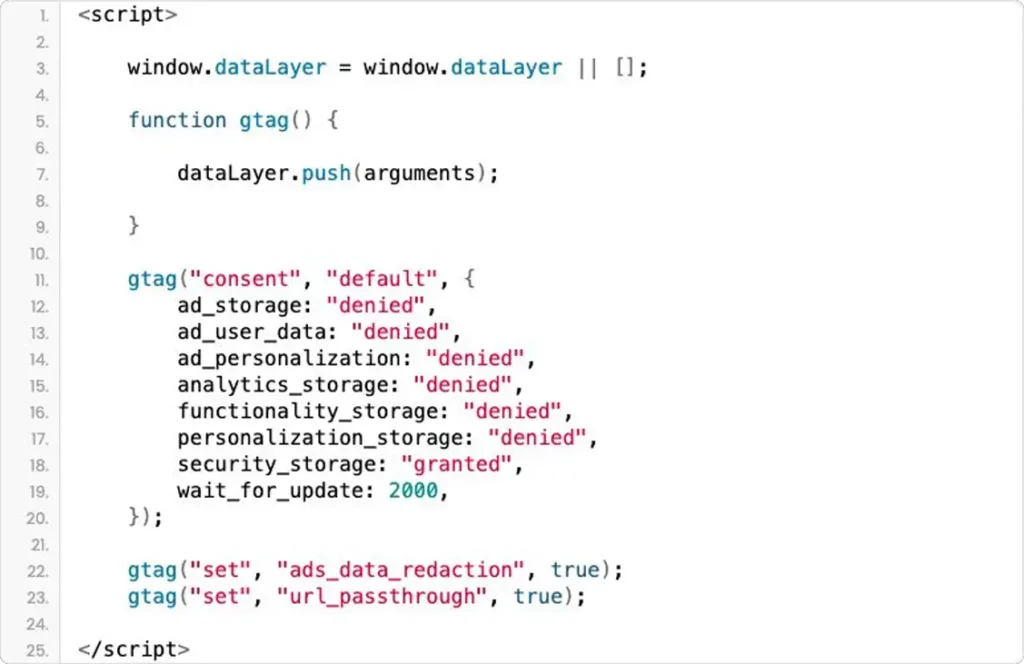
In cases of consent requests, tags hold built-in checks that are linked to the consent given by the users. But privacy tags could have consent settings particular to each image. To edit consent settings for a tag:To edit consent settings for a tag:
Please note in any graph tag that Advanced Settings > Consent Settings.
Refer review of the consent settings documented in Built-In Consent Checks. Tags that are built in with consent verifications have logic in them that either logically changes the execution of the tags or do nothing if the user does not give consent. Uncover Id consent mode operation through Google Ads, Google Analytics and Floodlight. Note: Additionally, as third-party consent management platforms use their own default implementation, they may also exhibit a variety of dispositional behaviors.
Select Additional Consent Checks
Not set: Default. This tag presents the same issues in terms of tracking as many other tags, namely that there is no additional ad trafficking or tracking of consent checks.
No additional consent required: Use this option if tag is not dependent on further consent to fire it. You may select this one to flag up tags that need no additional permission outsides their current setup which are already performing consent checks while other tags that you haven’t reviewed yet are staying.
Require additional consent for tag to fire: This tick will be triggered if and only if all specified consent types are granted when the event happens. By picking the link you will feel free to activate the + Add required consent button. Use this button as an option for adding yet more consent types. Thus, Tag Manager provides all the consent types mentioned in the table below and, in addition to that, it is possible to create the custom consent types that are supported by your consent machine.
Final Thoughts
Get started with Google Consent Mode, if your online business relies on services like paid ads, Google Analytics, and more. Don’t let the user’s data gaps put an obstacle in your personalized marketing campaigns. This API helps you to collect users’ data as per their consent and utilize the same for marketing purposes.
Collaborate with a leading digital marketing company in India like Hustle Marketers to enable the virtues of Google Consent Mode and other services. This company has transformed and accelerated the digital growth of several brands and helped enterprises generate substantial leads along with increased revenue.
FAQs
- How does Google Consent Mode helps my website?
By enabling the virtues of Google Consent Mode, you have user’s permission to save their data and make use for the marketing purpose.
- How can I enable the Google Consent Mode?
With the help of a reliable digital marketing agency, enable the required permissions and get to know the benefits later.
- What is the cost involved in Google Consent Mode?
Only cost that involves is getting the assistance of a trusted marketing company to enable the mode, do other marketing initiatives for you, and provide you substantial results.


